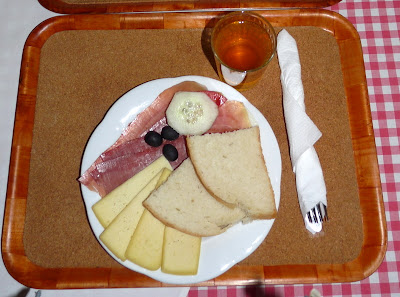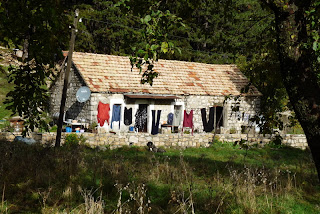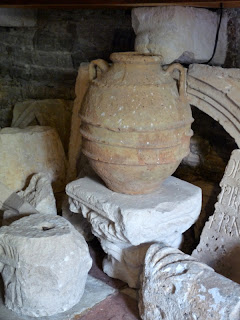After being part of Yugoslavia, the Republic of Montenegro declared its independence in 2006. It's a small piece of real estate, with 650,000 residents in an area about the size of Connecticut. Long overshadowed by its Croatian and Serbian neighbors, Montenegro has gone quietly about its business for centuries, well-insulated from the outside world's influence by its inhospitable terrain. Look at little closer and Europe's youngest nation has dramatic scenery, natural beauty, and intriguing history.
A cultural note: Among their Balkan neighbors, Montenegrins have a reputation for being lazy. The Montenegrins take this criticism in good humor and have even created the Montenegrin Commandments to clarify their philosophy on work. When asked about all the mis-spelled words, we were told (again), they're lazy, not stupid.
Bay of Kotor
With dramatic cliffs rising out of the Adriatic Sea, ancient towns filled with history, and an undeveloped ruggedness , the Bay of Kotor represents the best of Montenegro. The bay is the deepest natural fjord in the Mediterranean Sea, and the scenery around it is just spectacular. There is evidence of prehistoric settlements dating back to 2500 B.C., indicating that the bay has been a prized location for millennia. Its unique bottleneck shape makes the Bay of Kotor the single best natural harbor between Greece and Venice.
We had a look at the bay from high up on Mount Lovcen - the elevation is about 3000 feet above sea level and getting there is a ride not to be forgotten. From Kotor Town to the lookout point, we followed a narrow, mostly one-lane road, with 25 switchbacks and only occasional railings.
Butted up against a steep cliff, cradled by a calm sea, sheltered by its position deep in the fjord, and watched over by an imposing network of fortifications, the town of Kotor is as impressive as it is well-protected. It has been listed as a World Heritage Site by UNESCO.
The Old Town is shaped like a triangle, with the two sides facing the bay heavily fortified by a thick wall and the third side huddling under the cliff face. Kotor's Town Walls are among the most elaborate in all Europe. The fortifications begin as stout ramparts along the waterfront, then climb up the sheer cliff face behind town in a dizzying zig-zag line. This wall is three miles long, varies in thickness from 6 to 50 feet, and the tallest parts are 65 feet high.
The Old Town is shaped like a triangle, with the two sides facing the bay heavily fortified by a thick wall and the third side huddling under the cliff face. Kotor's Town Walls are among the most elaborate in all Europe. The fortifications begin as stout ramparts along the waterfront, then climb up the sheer cliff face behind town in a dizzying zig-zag line. This wall is three miles long, varies in thickness from 6 to 50 feet, and the tallest parts are 65 feet high.
The Main Town Gate welcomes visitors today, but for centuries its purpose was exactly the opposite - it was the primary point of entry into this heavily fortified town and the last line of defense. There was only room for one ship to tie up at a time - it was carefully examined and taxes levied before passengers could disembark. Above the gate is the old Yugoslav coat of arms and the present-day flag of Montenegro.
Just inside the gate is the Square of Arms, which is ringed with artifacts of the city's history. On one side is a building that once was the Palace of the Rector, who ruled the city on behalf of Venice - princes could watch action from their long balcony overlooking the square, which served as the town's living room. Later, the palace became the Town Hall - today it is lined with cafes that have curious umbrellas that seem to be upside down. It turns out that these large funnels collect rainwater which is stored in a large cistern.
Directly across from the main gate is the town's Bell Tower, one of Kotor's symbols. The odd triangular structure at its base was once the town pillory, where wrongdoers were chained and subjected to public ridicule.
The Palace of the Pima family is a good example of 17th century baroque architecture. Pima was a wealthy merchant.
Because of the strong influence of nearby Serbia, signs in Kotor are sometimes written in two alphabets - Cyrillic and Latin letters.
Even though most Kotorians are Orthodox, Kotor's most significant church is Catholic - the Cathedral of St. Tryphon. The chapel here holds the remains of St. Tryphon, the patron saint of Kotor. The earliest parts of the church, dating from the mid-12th century, dating to the time of rule by the Roman Catholic Venetians; only about 5% of population is Catholic today.
St. Nicholas Church is the biggest Orthodox church in the Old Town. Nearby is the older church of St. Luka, which once was a Catholic church and now is an Orthodox church.
Like many Adriatic towns, Kotor's livelihood is tied to the sea, and that heritage is explored in the Maritime Museum of Montenegro. Maps, etchings, portraits, costumes and lots of model ships tell the story of Kotor's rich history.
The town may seem like a museum, but look again - there's always a coffee shop around the next corner and folks park their bikes when they come into the town.
We walked around the lower walls to find one of the 'back' entrances - it was pretty well hidden in the cliff wall and had a drawbridge that could be pulled up for protection.
And, after all that walking ... we tried a traditional Montenegrin dessert - Moskva Cake. It consisted of layers of pastry alternating with pineapple, cherries, and almonds - and lots of thick vanilla custard to hold it all together. Yummy.
We stayed in port overnight, which was a good excuse for karaoke night - time for the passengers to entertain themselves - and the crew. Talent was in somewhat short supply, but there was plenty of fun as the crew passed around the microphone.
Njegusi
In spite of all that partying, we were up early to cross over the mountains to visit the village of Njegusi. This little village is well-known among Montenegrins, with two important claims to fame. First, Njegusi was the hometown of the House of Petrovic-Njegos, the dynasty that ruled Montenegro for much of its history (1813-1851). The family's favorite son was Petar II, a poet and playwright.
Of more interest to us, the town of Njegusi is famous for producing its own type of air-dried ham, called Njeguski prsut. Locals explain that the wind changes directions here ten times each day, alternating between dry mountain breeze and salty sea air - perfect for seasoning and drying ham hocks. For good measure, the prsut is also smoked with beech wood.
We stopped at roadside establishment owned by the family Radonjica to sample some of the local delicacies: dried ham (prsut), dried goat cheese (sir), homemade bread, and honey wine. Quite a nice snack!
It's hard to imagine how folks here make a living - rocks and hills and hills and rocks - and no source of water, except rainwater collected in cisterns during the rainy winter months. Our guide told us that we should see why our ancestors left Europe - it was not because things were so good, but because life was so hard.
This house is typical of the area - made of stone, clothes hanging on a line - and a satellite dish! In front of the stone wall, there is the biggest dog any of us had ever seen - it is a Macedonian shepherd - said to be so brave that it will attack a bear or even a helicopter.
Cetinje
Cetinje is the historic capital of Montenegro and remains a city of great historical and spiritual value to the nation. It has been the home of the Montenegrin king since the 15th century. During the siege by the Ottoman Empire, the country itself was reduced to just Cetinje and its surroundings.
Due to the strategic nature of Montenegro as an independent state on the border of the Ottoman Empire, all of the major European powers had an embassy here. For this reason, its architectural style is a bit different than other towns. This one is the former Belgian embassy.
Due to the strategic nature of Montenegro as an independent state on the border of the Ottoman Empire, all of the major European powers had an embassy here. For this reason, its architectural style is a bit different than other towns. This one is the former Belgian embassy.
The National Museum at King Nicholas Square was once the palace of King Nikola Petrovic I, who ruled from 1860 to 1918. His residence is quite humble as royal palaces go, but Nikola thought big - he married off five daughters into the various royal families of Europe.
Nearby is the birthplace of the town, the Cetinje Monastery. It is dedicated to St. Peter of Cetinje, a legendary local priest who carried a cross in one hand and a sword in the other. This is the most famous Serbian Orthodox church and monastery in Montenegro.
Also nearby is the Court Church (Catholic), erected by King Nikola on the site of an older Serbian Orthodox monastery that once stood here. King Nikola and Queen Milana are buried here.
The road out of Cetinje twists through the mountains into a rugged and inhospitable landscape. Along this mountain road, rocks are painted with the phone number of a road repair service - just in case. Low-profile plaques mark the sites of Tito-era ambush assassinations.
Perast
This little town is known as the 'Pearl of Venetian Baroque.' Perast was an essential link in the Bay of Kotor and the rulers in Venice rewarded Perast with privileged tax-free status. As a result, the town became extremely wealthy and many ornate mansions were built during the 17th and 18th centuries. Overlooking a long and narrow harborfront square is the Church of St. Nicholas, dedicated to the patron saint of fishermen.
Between Perast and the bay's bottleneck, Our Lady of the Rocks is a Catholic church perched on an artificial island created by a bulwark of rocks and by sinking old and seized ships loaded with rocks. According to legend, the islet was made over the centuries by the seamen who kept an ancient oath after finding an icon of Madonna and Child on the rock in the sea in 1452.
Upon returning from each successful voyage, they laid a rock in the Bay - over time, the islet gradually emerged from the sea. We followed this tradition as well - we brought some rocks from the mountains to add to the reef around the church.
The first known church was built on the islet in 1452 and it was Serbian Orthodox. It was taken over by the Roman Catholics, and in 1632, the present Church of Our Lady of the Rocks was built. The church houses many paintings, artifacts and gifts left by thankful sailors.






































No comments:
Post a Comment